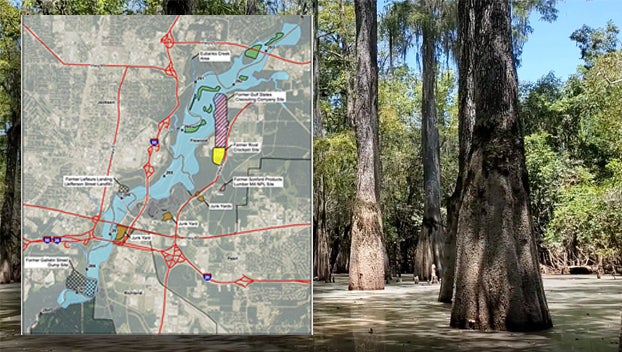Letters from Mississippi, Louisiana officials about plans to transform Pearl River flood Corps of Engineers Office
Published 6:30 am Thursday, July 13, 2023
Local governments affected by a proposal to transform the Pear River into one large lake — a plan called “One Lake” by some officials — have written letters detailing their support, opposition and concerns for the proposals.
The deadline for public comment on the US Army Corps of Engineers’ plans for the Pearl River Flood Mitigation Project expired at the beginning of July. Pearl Riverkeepers, a non-profit organization focused on clean water and a healthy river, collected a series of letters and resolutions from public bodies such as local governments, and state and federal agencies, which were addressed to the Corps of Engineers.
Broadly, the letters agreed there was a need for flood risk mitigation for Jackson but urged the corps of engineers to pursue plans which did not change the Pearl River. Lynn Posey, Executive Director of the MDWFP, wrote in a letter to the USACE and stated in the first paragraph there is a demonstrated need for flood mitigation, and the department supports the need for a plan. Posey wrote the department supports an option that would minimize wildlife, fisheries and habitat harm.
Pearl River’s system supports 140 different species of fish, 14 species of turtles, 40 species of mussels and other aquatic species. United States Fish and Wildlife Service reported 2,069 acres of terrestrial habitat could be lost to aquatic habitat under alternative plan C. USFWS reports 1,861 acres of wetland habitat and 487 existing surface water bodies would be impacted by the plan to “improve” the channel of the Pearl River if USACE went with plan C. LeFleur’s Bluff would also be impacted by any changes to the Pearl River.
“MDWFP believes all project alternatives should seek to avoid fish and wildlife habitat losses and next seek to minimize losses,” Posey wrote. “If habitat losses are unavoidable, we contend the losses should be fully mitigated for in a reasonable timeframe by protecting, enhancing or restoring the same habitat type that was impacted, reduced, converted or lost.
James Austin, Mississippi Field Supervisor with the United States Fish and Wildlife Service, wrote to the corps of engineers and addressed project proposal C as having areas of concern. Similar to the MDWFP, the United States Fish and Wildlife Service referenced the habitat, fish and wildlife impacts the alternative C project would bring in recommending other alternatives be explored. There are several species of concern that call the Pearl River home.
“The Pearl River and its associated riparian and wetland habitats in the study area encompass habitat for several threatened, endangered, and at-risk species including Gulf sturgeon, inflated heelsplitter, Louisiana pigtoe, Monarch butterfly, northern long-eared bat, tri-colored bat, alligator snapping turtle, ringed map turtle, and Pearl River map turtle,” Austin wrote. “These species could be impacted by actions in each of the alternatives presented. In alignment with Section 7(c) of the ESA, the Service recommends that the Corps prepare a biological assessment to determine the effects of the recommended plan on the above-mentioned species.”
USFWS questioned why alternative B, which would have built levees, was no longer being considered by the Corps of Engineers. They wrote the alternative C plan could require dredging, which would then damage the habitat by reducing prey species, removing shelter and spawning habitat and causing mortality to aquatic species. The widening of the river could cause the weakening of the banks, which was one of the concerns expressed by Monticello mayor Martha Watts.
Section manager Ntale Kajumba wrote a letter on behalf of the United States Environmental Protection Agency. The first paragraph of the letter points to the alternative C plan, which would make a “one lake” of 1,500 acres by excavating 4,900 acres to widen the Pearl River channel.
“The EPA is concerned about the disruption in downstream freshwater flow, changes in water quality, water quality modeling, and habitat impacts which also may affect endangered species, fisheries, and oyster production,” Kajumba wrote. “The EPA has also identified potential issues to evaluate in the EIS, including environmental justice, contaminated sites’ proposed remediation, and critical infrastructure.”
Louisiana’s state legislature asked the US Corps of Engineers in a letter to explore all options and alternatives and pleaded a case for the environmental impacts One Lake would have on the state’s natural resources, such as their oysters. Louisiana Senator Malinda B. White, who represents Washington Parish in her district, urged the Corps of Engineers to consider the people downstream of Jackson.
“I expect the needs and concerns of the whole Pearl River basin be taken into consideration in any alternatives that are formulated, published and supported by the Army Secretary,” White wrote. Her 12-page letter included a very detailed examination of each aspect of the mitigation plan and any negative impacts project “One Lake” would have.
St. Tammany Parish wrote a 29-page letter in response to the project and echoed many points made by other responding parties. Marion County’s board of supervisors passed a resolution where they opposed alternative C, aka project “One Lake,” due to the detrimental effects it would have on people and communities downstream. Monticello’s City Government wrote it was “vehemently opposed” to alternative C.
St. Tammany Parish Levee, Drainage and Conservation District commissioner Stanford A. Owen asked for more impact statements to be gathered for the project in a letter addressed to the Corps of Engineers.
“The impacts will be felt for decades or even centuries,” Owen wrote. “There is no rush, and there should be no rush.”
Slidell’s city government passed a resolution to “continue opposition to the proposed plan,” citing concerns shared by many other agencies.






